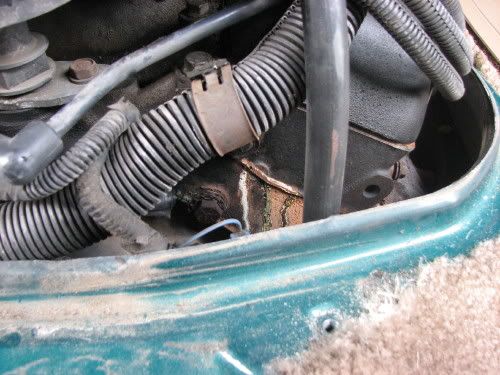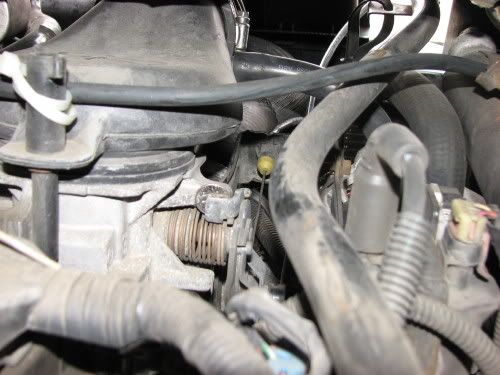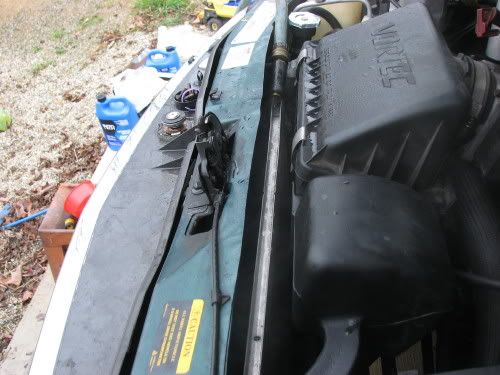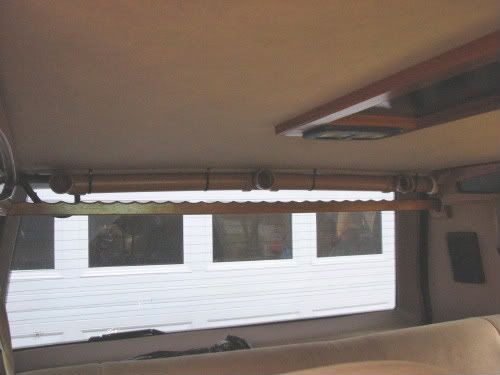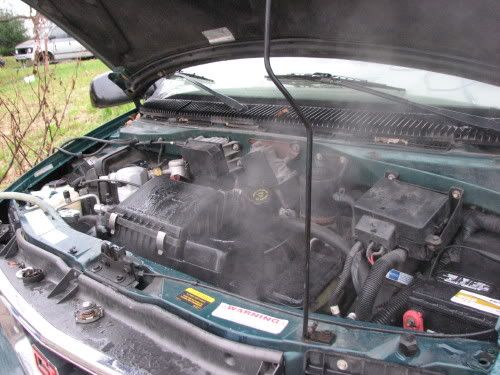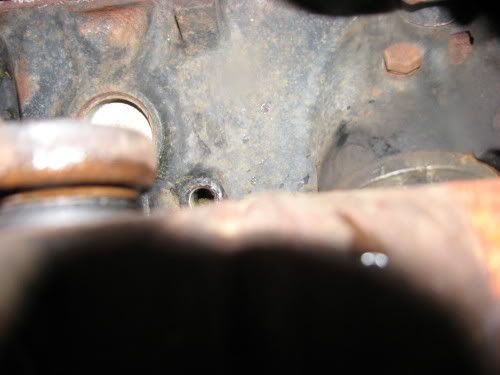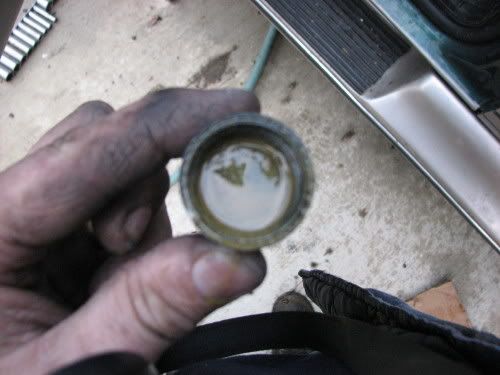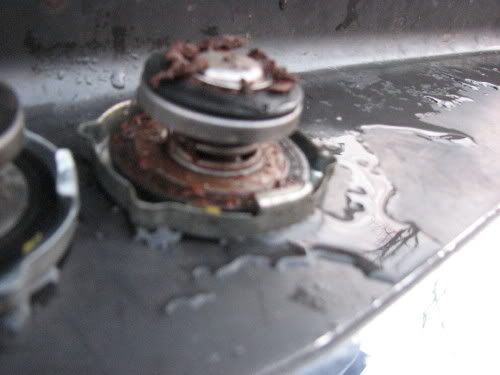How to get rid of Dexcool (long)
Posted: Thu Nov 19, 2009 7:29 pm
I'm going to rid my '99 of the remaining Dexcool sludge that has been killing waterpumps and making me crazy.
Some of this content is original, but most has been pulled form the net. I tryed to find multple sourses for the same info to verify authenticity.
After reding up, I found that Prestone used to make a cleaner for GM P/N 12346500. It was also sold under Prestone P/N AS100 Heavy Duty Cooling System Cleaner. It was a 2 part acid based cleaner w/neutralizer, and actually worked.
It is not made anymore but these are the components.
9 dry oz of Oxalic Acid (such as DAP Wood Bleach) I got mine at Sherwin Williams, I was there getting paint for the never ending house addition.
2 dry oz of Sodium Carbonate (Arm & Hammer Super Washing Soda) Note that it is washing soda and not baking soda. They are not interchangable.
Here is the GM TSB and Instructions #99-06-02-012D:
Condition
Some customers may comment that the heater is inoperative, blows cold air, engine may exhibit an overheat condition or the coolant reservoir has rust in it.
Cause
Vehicles equipped with DEX-COOL® coolant, which may have been operated for extended periods of time with a low coolant level, usually in excess of 32,000 km (20,000 mi), may be susceptible to the formation of a rust-like material in the cooling system.
Correction
Flush the cooling system using the repair procedures that follow.
Parts and equipment required/suggested for this correction are listed below.
• 1 each *Prestone® Flush and Fill Kit #AF-KITP U.S. (#00050 in Canada). This kit can be obtained from your local parts supplier and can be used on all vehicles repaired under this procedure. Save it after performing the repair, as it is reusable.
• 1 each *Prestone® Heavy Duty Cooling System Cleaner, GM P/N 12346500 - 1 per vehicle. This cleaner is in powder form and contains a neutralizer. Do not substitute other cleaners. The diluted cleaners that are available in liquid form are not recommended for this repair.
• 5.7 L (6 qt) of 100% (non-diluted) DEX-COOL® coolant (GM Spec 6277M).
• 1 each new thermostat, GM P/N 12563335.
• 2 each new radiator cap, GM P/N 15075565.
• 1 each *Prestone® yellow funnel. This funnel can also be obtained from your local parts supplier. It fits snugly into the radiator opening for an easy fill and is reusable.
*We believe this source and their products to be reliable. There may be additional manufacturers of such products. General Motors does not endorse, indicate any preference for or assume any responsibility for the products from this firm or for any such items which may be available from other sources.
Important: Verify the fuel level in the fuel tank. The fuel level should be above ¼ tank before this procedure is started.
As a precaution, verify the oil level in the crankcase. Add the amount required to bring the oil level into the normal range.
It is recommended the vehicle be placed in a position so that the following are available:
• A sanitary sewer -- not a storm drain, etc
• A monoxivent system (if the outside temperature is less than 10°C (50°F)).
• Hot running water
Notice: Due to the complexity of these procedures, the following repair steps must be strictly adhered to in order to achieve the intended results. Any deviation or substitution may result in sub-standard cleaning/flushing results or system damage.
Diagnostic Procedure
Install the Scan Tool. This will allow monitoring of the coolant temperature throughout the procedure.
Caution: As long as there is pressure in the cooling system, the temperature can be considerably higher than the boiling temperature of the solution in the radiator without causing the solution to boil. Removal of the radiator cap while the engine is hot and pressure is high will cause the solution to boil instantaneously - possibly with explosive force - spewing the solution over the engine, fenders and the person removing the cap. Under some conditions, the engine coolant is combustible.
Important: • The installation of a NEW radiator cap at the beginning of this procedure and the second new cap at the end of the repair procedure is necessary in order for the correct pressure to be achieved and for the repair to be completed successfully.
• The radiator cap is NOT a good indicator of the general condition of the cooling system. Typically the underside of the radiator cap will exhibit a greater amount of contamination than the rest of the system. It is important to evaluate the condition of the cooling system by checking the following before beginning the repair procedure:
Remove the radiator cap. Install a new radiator cap, GM P/N 15075565. A properly operating radiator cap is essential for this procedure to work properly. Be sure to wipe off all radiator cap sealing surfaces prior to installation.
Start the engine.
Using a flashlight or lead light, look into the radiator. From the right side of the vehicle, peer into the radiator toward the left side of the vehicle. Observe the top three rows (or tubes) of the radiator. (It may be necessary to drain off some of the coolant to see the top three rows of the radiator).
If it appears the coolant is able to flow through the third row down from the top, the vehicle should be repaired using Procedure A. If it appears the coolant is NOT able to flow through the third row down from the top, then the vehicle should be repaired using Procedure B.
Stop the engine.
Repair Procedure A & B
Important: • If available, use coolant exchanger Pro-Fill 42-75100-KM, Power Flush 211-07601/DEX (available through the GM Dealer Equipment program), or equivalent to evacuate the system of coolant. Follow the manufacturer's instructions for exchanging used coolant with new coolant. However, for this procedure, use water in place of new coolant. Be sure to exchange 1½ times the cooling system capacity of the vehicle with water. This will ensure that only water remains within the cooling system. Once the coolant has been displaced with water, drain the water from the radiator.
• If you are located within an area which regulates the disposal of used coolant (check with your local water treatment facility), all coolant and coolant/water mixture must be captured until the water runs clear of coolant. Use a clean 208 L (55 gal) drum or similar to contain the waste coolant. Refer to Corporate Bulletin Number 00-06-02-006 for information on coolant recycling and removal services.
Drain and properly dispose of the coolant.
Caution: Any obstructions in the hoses to or from the coolant recovery bottle may cause over-pressurization of the cooling system. This over-pressurization could result in serious personal injury.
Inspect the following hoses in order to assure there are no obstructions and the coolant is able to flow freely: • The hose to the coolant recovery bottle.
• The relief hose from the coolant recovery bottle.
Disconnect both coolant hoses to the heater core from the engine.
Back flush the heater core for 5 minutes after clear water is present. Pressurized water not to exceed 345 Kpa (50 psi), may be used.
Reinstall the heater return hose to the engine.
Install the radiator cap and properly tighten.
Install the "T" from the flush and fill kit to a 25.4 cm (10 in) piece of 19 mm (¾ in) heater hose. Tighten the clamp.
Install the hose to the engine. Tighten the clamp.
Install the other end of the "T" in the heater core inlet hose. Tighten the clamp.
Disconnect the upper radiator hose from the radiator. Properly position the hose, so the accessory drive belt or any pulley/belt cannot touch the hose.
If you used coolant exchange equipment, disconnect it.
Attach a garden hose to the "T" of the flush and fill kit. Turn on the water and back flush the cooling system for at least two minutes after the water runs clear.
Start the engine and continue back flushing the cooling system for five additional minutes.
Turn the engine "OFF".
Turn the water "OFF".
Re-attach the upper radiator hose to the radiator.
Open the radiator drain and drain all water from the radiator.
Remove the lower left water pump crossover bolt. This allows lowering the water level in the left side of the engine.
After the water stops running from the water pump bolt hole, reinstall the bolt.
Close the radiator drain.
Mix the Prestone® Heavy Duty Cooling System Cleaner, GM P/N 12346500, in approximately 3 L (3 qt) of warm water. Pour the mixture into the radiator. Top off the system with plain water and reinstall the radiator cap.
Run the engine at 1600 to 1800 RPM with the air conditioning in the maximum cool position.
To achieve the 1600 to 1800 RPM, place a dime between the closed throttle stop and the screw. This screw should never be adjusted, under any circumstance. Its only purpose is to keep the throttle plate from sticking in the bore when the throttle is slammed shut. It is not a minimum idle (RPM) control adjustment screw.
Important: It is imperative that all air pockets have been removed from the cooling system in order for the cleaning procedure to be effective.
Service Procedure A
For Service Procedure A, the cleaner should be left in the system for three hours (after normal operating temperature of the cooling system has been achieved). Normal operating temperature is when the coolant temperature stabilizes around 98°C (200°F). The best results are obtained when the coolant temperature is between 98°C (200°F) and 110°C (230°F). DO NOT EXCEED 113°C (235°F). Use the Scan Tool to determine when this point has been reached. When this temperature has been reached, start the clock. Periodically (every twenty minutes or so), monitor the coolant temperature and engine during the three hour run time. A half hour has been built into the actual labor time to cover for the time spent monitoring the engine, etc.
In order to achieve a constant temperature of 98°C (200°F) to 110°C (230°F) during this procedure, maintain the idle speed, turn on the A/C or partially close the hood.
Service Procedure B
For Service Procedure B, the cleaner should be left in the system for two and a half hours (after normal operating temperature of the cooling system has been achieved). Normal operating temperature is when the coolant temperature stabilizes around 98°C (200°F). The best results are obtained when the coolant temperature is between 98°C (200°F) and 110°C (230°F). DO NOT EXCEED 113°C (235°F). Use the Scan Tool to determine when this point has been reached. When this temperature has been reached, start the clock. Periodically (every twenty minutes or so), monitor the coolant temperature and engine during the two and a half hour run time. A half hour has been built into the actual labor time to cover for the time spent monitoring the engine, etc.
In order to achieve a constant temperature of 98°C (200°F) to 110°C (230°F) during this procedure, maintain the idle speed, turn on the A/C or partially close the hood.
Important: The vehicle should not be left idling outdoors when the ambient temperature is below 10°C (50°F). The flushing procedure relies on heat as a catalyst in order to be effective. Ambient temperatures below 10°C (50°F) do not allow sufficient cycling of the thermostat to effectively clean the cooling system.
Turn off the engine.
Remove the dime from the closed throttle stop screw. Do NOT remove the radiator cap. Following the procedure listed below will assist you in draining the cooling system thoroughly. • Place a drain pan under the radiator drain hose.
Caution: The cooling system and coolant are hot and under pressure. Loosen only the radiator drain until the pressure has been released from the cooling system and follow the procedures exactly in this bulletin, using normal safety precautions to avoid being injured by the hot coolant mixture.
• Loosen the radiator drain. Drain approximately 1 L (1 qt) of liquid from the system.
• After the pressure has been released from the cooling system, slowly loosen the radiator cap to the safety stop. Do not remove the cap (This releases the spring pressure on the secondary seal while retaining the primary seal to the top of the filler neck and will allow the coolant reservoir to be evacuated).
• When the coolant reservoir is empty, re-tighten the radiator cap fully.
• Remove the cap from the flush and fill "T". This will allow the coolant to be siphoned from the heater core and the engine block.
• When the water has stopped coming out of the radiator drain hose, close the radiator drain. Do not place the cap on the "T".
Using Prestone® Heavy Duty Cooling System Cleaner, GM P/N 12346500, mix the neutralizer (from the bottom of the can) with approximately 3 L (3 qt) of warm (shower temperature) water.
Notice: Do not put cold water into a hot engine as engine damage may occur.
Under no circumstances should the neutralizer be left in the cooling system for any longer than ten minutes once the vehicle has reached operating temperature (thermostat open). The neutralizer is corrosive to aluminum and will damage system components if it is left in the cooling system for longer than ten minutes.
Pour the mixture from the step above into the radiator.
Completely refill the cooling system with warm to hot water through the "T". When the radiator is full, install the radiator cap to the safety catch. Continue to fill until the overflow reservoir is filled to the hot line on the reservoir.
Remove the fill hose and install the cap on the "T" and the radiator fully.
Important: It is imperative that all air pockets have been removed in order for the procedure to be effective.
Start the engine. After engine speed stabilizes, reinstall the dime between the closed throttle stop and the screw. With the A/C on, bring the cooling system back to normal operating temperature and follow the directions on the can.
Turn off the engine.
Remove the dime from the closed throttle stop and the screw.
Caution: As long as there is pressure in the cooling system, the temperature can be considerably higher than the boiling temperature of the solution in the radiator without causing the solution to boil. Removal of the radiator cap while the engine is hot and pressure is high will cause the solution to boil instantaneously - possibly with explosive force - spewing the solution over the engine, fenders and the person removing the cap.
Drain the cooling system, following the procedure listed in Step 24 above.
Do not close the radiator drain. Leave it open.
Disconnect the upper radiator hose from the radiator. Properly position the hose, so the accessory drive belt or any pulley/belt cannot touch the hose.
Attach a garden hose to the "T" of the flush and fill kit. Turn on the water and back flush the cooling system for at least two minutes after the water runs clear.
Start the engine and continue back flushing the cooling system for five additional minutes.
Turn the engine "OFF".
Turn the water "OFF".
Close the radiator drain.
Important: If the repair is a Procedure A, go to Step 40.
If the repair is a Procedure B, remove the radiator and have it recorded and steam clean the end tanks. After reinstalling the radiator, continue to Step 40.
Remove the air cleaner housing and tube assembly from the throttle body.
Remove the two nuts holding the throttle cable bracket to the throttle body and position the bracket and the cables out of the way.
Remove the thermostat.
Remove the previously installed flush kit "T" and hose. Save for future use on other vehicles.
Install the heater inlet hose to the intake manifold and secure with the original spring clamp.
Inspect the thermostat opening and cover for foreign material. Clean if necessary.
Remove the left lower water pump crossover bolt to drain the left side of the block and the left cylinder head.
Install sealant to the bolt threads, using GM P/N 12346004 (Canada GM P/N 10953480), or equivalent and reinstall the water pump crossover bolt.
Tighten
Tighten the bolt to 41 N·m (30 lb ft).
If available, use coolant exchanger Pro-Fill, Power Flush, or equivalent to fill the system with 50/50 DEX-COOL® coolant. If a coolant exchanger is not available, proceed to the next step now. Follow the manufacturer's instructions for system fill/coolant exchange. If you are using coolant exchange equipment, you will need to install a new thermostat, GM P/N 12563335 and top off the system with clean drinkable water prior to exchanging. After exchanging, install the upper radiator hose and clean out the coolant recovery bottle. Proceed to Step 56.
Pour 5.6784 L (6 qts) of 100% (not pre-mixed) DEX-COOL® coolant into a clean container.
Using a clean funnel, pour as much of the 100% DEX-COOL® coolant that you can into the engine through the thermostat opening.
Install a new thermostat, GM P/N 12563335.
Tighten
Tighten the bolt to the specified torque of 19 N·m (14 lb ft).
Hold the upper radiator hose in the straight up position and pour 0.473 L (1 pint) of the 100% DEX-COOL® coolant into the hose.
Install the upper radiator hose to the radiator and properly position the clamp.
Flush the coolant recovery bottle thoroughly.
Complete the fill of the cooling system with the balance of the 5.7 L (6 qt) of 100% DEX-COOL® coolant and top off with plain water. If the water is not drinkable, do not use. Water must be clean and fresh.
Important: The second new radiator cap must be installed at this point of the procedure. It is possible that small contaminants may have become lodged in portions of the first cap during the cleaning procedure.
Clean the radiator cap sealing surfaces on the radiator. Install the radiator cap, GM P/N 15075565.
Important: It is imperative that all air pockets have been removed in order for the cooling system to function properly.
Run the engine to operating temperature with the air conditioning in the maximum cool position for ten minutes.
Caution: As long as there is pressure in the cooling system, the temperature can be considerably higher than the boiling temperature of the solution in the radiator without causing the solution to boil. Removal of the radiator cap while the engine is hot and pressure is high will cause the solution to boil instantaneously - possibly with explosive force - spewing the solution over the engine, fenders and the person removing the cap. Under some conditions, the engine coolant is combustible.
Turn the engine "OFF" and let it cool.
Check the coolant concentration for a 50/50 mix, using refractometer J 26568 (Centigrade scale) or J 23688 (Fahrenheit scale). Follow the manufacturer's directions for using the coolant tester. Unless your coolant tester has a provision for temperature correction, it is imperative that the correct coolant temperature is achieved when testing the coolant. If the coolant is warmer or cooler, the reading may be incorrect.
Top off the radiator and fill the coolant recovery bottle to 2.54 cm (1 in) above the full hot mark on the coolant reservoir. Add the appropriate coolant mixture to come to a 50/50 mix of the DEX-COOL® coolant.
Important: To assure intended system performance, inform the customer that the cooling system MUST be maintained in a completely full condition.
Parts Information
Part Number
Description
12346500
Prestone® Heavy Duty Cooling System Cleaner (see note above)
12563335
Thermostat (I used a Stant 195 degree thermostat, #14119)
15075565
Radiator Cap (I used a new Stant 16 lb non-vented cap, #11230)
I did not use dexcool, since it is the devil's urine.
I started out by draining and flushing the system with the hose. I put 2 Ts in the system, one in the rear heater hose under the van, and one in the hose by the blower, since it is easier to access. I flushed, backflushed, opened the drain plugs in the block, etc, until all I got was clean water. Then I pulled the shroud and fan, and opened every hose and the drain on the radiator, and flushed every possible way. I plulled the thermostat and it had gritty crap on it. I flushed the intake, and put the thermostat back in since it looked OK. I'll change to the new one when I'm done. I drained and reassembled the van to get ready for the acid flush in the morning, other than pulling the recovery tank to take it inside and clean it with Oxyclean (r.i.p. Billy Mays).
Anyway, I am going to follow the TSB for the most part, I am using distilled water with the acid since my water is high in ph. I am leaving the fan off, since it is November and cold, so that the engine will acheive 200+ degrees. I'm hoping this will work to increase the temp, I've only seen this van hit 210 one time, it was about 100 degrees, idling in the sun, MAX A/C, and would cycle to 210 and back down. Normally, it never moves the gauge past 1/3 of the way (don't know what degree that is, lol) 210 is the middle. No idea why. I'll hose down the rad if it gets hot, or put a fan in front of the van or something. I'll have to watch it. I'll be sorting the utility grade flooring for my addition only a few feet away, so the 3 hours should go fast.
I'll have to let it cool. I'm going to pull the dog house at some point to look for leaks. Prolly during the 3 hour run time.
Then I plan to flush and drain, fill with water from the hose and run the Sodium Carbonate for the required 10 minutes. Then it's drain and flush, cool, then change the pump and thermostat, and hoses and whatever else, and if the intake gaskets are leaking (Man, I hope not) I'll do them too. I so hope that they aren't, maybe it's the rear heater hose or something, but it seems to leak from the left rear of the engine.
My only worry is that the waterpump will fail before 3 hours is up, or it will run low on coolant, since the bearing is leaking. Well, that and the intake gaskets.
Once all is sealed up, it's a 50/50 mix of new green antifreeze and distilled water, and hope for the best. Oh, and an oil change for good measure.

Some of this content is original, but most has been pulled form the net. I tryed to find multple sourses for the same info to verify authenticity.
After reding up, I found that Prestone used to make a cleaner for GM P/N 12346500. It was also sold under Prestone P/N AS100 Heavy Duty Cooling System Cleaner. It was a 2 part acid based cleaner w/neutralizer, and actually worked.
It is not made anymore but these are the components.
9 dry oz of Oxalic Acid (such as DAP Wood Bleach) I got mine at Sherwin Williams, I was there getting paint for the never ending house addition.
2 dry oz of Sodium Carbonate (Arm & Hammer Super Washing Soda) Note that it is washing soda and not baking soda. They are not interchangable.
Here is the GM TSB and Instructions #99-06-02-012D:
Condition
Some customers may comment that the heater is inoperative, blows cold air, engine may exhibit an overheat condition or the coolant reservoir has rust in it.
Cause
Vehicles equipped with DEX-COOL® coolant, which may have been operated for extended periods of time with a low coolant level, usually in excess of 32,000 km (20,000 mi), may be susceptible to the formation of a rust-like material in the cooling system.
Correction
Flush the cooling system using the repair procedures that follow.
Parts and equipment required/suggested for this correction are listed below.
• 1 each *Prestone® Flush and Fill Kit #AF-KITP U.S. (#00050 in Canada). This kit can be obtained from your local parts supplier and can be used on all vehicles repaired under this procedure. Save it after performing the repair, as it is reusable.
• 1 each *Prestone® Heavy Duty Cooling System Cleaner, GM P/N 12346500 - 1 per vehicle. This cleaner is in powder form and contains a neutralizer. Do not substitute other cleaners. The diluted cleaners that are available in liquid form are not recommended for this repair.
• 5.7 L (6 qt) of 100% (non-diluted) DEX-COOL® coolant (GM Spec 6277M).
• 1 each new thermostat, GM P/N 12563335.
• 2 each new radiator cap, GM P/N 15075565.
• 1 each *Prestone® yellow funnel. This funnel can also be obtained from your local parts supplier. It fits snugly into the radiator opening for an easy fill and is reusable.
*We believe this source and their products to be reliable. There may be additional manufacturers of such products. General Motors does not endorse, indicate any preference for or assume any responsibility for the products from this firm or for any such items which may be available from other sources.
Important: Verify the fuel level in the fuel tank. The fuel level should be above ¼ tank before this procedure is started.
As a precaution, verify the oil level in the crankcase. Add the amount required to bring the oil level into the normal range.
It is recommended the vehicle be placed in a position so that the following are available:
• A sanitary sewer -- not a storm drain, etc
• A monoxivent system (if the outside temperature is less than 10°C (50°F)).
• Hot running water
Notice: Due to the complexity of these procedures, the following repair steps must be strictly adhered to in order to achieve the intended results. Any deviation or substitution may result in sub-standard cleaning/flushing results or system damage.
Diagnostic Procedure
Install the Scan Tool. This will allow monitoring of the coolant temperature throughout the procedure.
Caution: As long as there is pressure in the cooling system, the temperature can be considerably higher than the boiling temperature of the solution in the radiator without causing the solution to boil. Removal of the radiator cap while the engine is hot and pressure is high will cause the solution to boil instantaneously - possibly with explosive force - spewing the solution over the engine, fenders and the person removing the cap. Under some conditions, the engine coolant is combustible.
Important: • The installation of a NEW radiator cap at the beginning of this procedure and the second new cap at the end of the repair procedure is necessary in order for the correct pressure to be achieved and for the repair to be completed successfully.
• The radiator cap is NOT a good indicator of the general condition of the cooling system. Typically the underside of the radiator cap will exhibit a greater amount of contamination than the rest of the system. It is important to evaluate the condition of the cooling system by checking the following before beginning the repair procedure:
Remove the radiator cap. Install a new radiator cap, GM P/N 15075565. A properly operating radiator cap is essential for this procedure to work properly. Be sure to wipe off all radiator cap sealing surfaces prior to installation.
Start the engine.
Using a flashlight or lead light, look into the radiator. From the right side of the vehicle, peer into the radiator toward the left side of the vehicle. Observe the top three rows (or tubes) of the radiator. (It may be necessary to drain off some of the coolant to see the top three rows of the radiator).
If it appears the coolant is able to flow through the third row down from the top, the vehicle should be repaired using Procedure A. If it appears the coolant is NOT able to flow through the third row down from the top, then the vehicle should be repaired using Procedure B.
Stop the engine.
Repair Procedure A & B
Important: • If available, use coolant exchanger Pro-Fill 42-75100-KM, Power Flush 211-07601/DEX (available through the GM Dealer Equipment program), or equivalent to evacuate the system of coolant. Follow the manufacturer's instructions for exchanging used coolant with new coolant. However, for this procedure, use water in place of new coolant. Be sure to exchange 1½ times the cooling system capacity of the vehicle with water. This will ensure that only water remains within the cooling system. Once the coolant has been displaced with water, drain the water from the radiator.
• If you are located within an area which regulates the disposal of used coolant (check with your local water treatment facility), all coolant and coolant/water mixture must be captured until the water runs clear of coolant. Use a clean 208 L (55 gal) drum or similar to contain the waste coolant. Refer to Corporate Bulletin Number 00-06-02-006 for information on coolant recycling and removal services.
Drain and properly dispose of the coolant.
Caution: Any obstructions in the hoses to or from the coolant recovery bottle may cause over-pressurization of the cooling system. This over-pressurization could result in serious personal injury.
Inspect the following hoses in order to assure there are no obstructions and the coolant is able to flow freely: • The hose to the coolant recovery bottle.
• The relief hose from the coolant recovery bottle.
Disconnect both coolant hoses to the heater core from the engine.
Back flush the heater core for 5 minutes after clear water is present. Pressurized water not to exceed 345 Kpa (50 psi), may be used.
Reinstall the heater return hose to the engine.
Install the radiator cap and properly tighten.
Install the "T" from the flush and fill kit to a 25.4 cm (10 in) piece of 19 mm (¾ in) heater hose. Tighten the clamp.
Install the hose to the engine. Tighten the clamp.
Install the other end of the "T" in the heater core inlet hose. Tighten the clamp.
Disconnect the upper radiator hose from the radiator. Properly position the hose, so the accessory drive belt or any pulley/belt cannot touch the hose.
If you used coolant exchange equipment, disconnect it.
Attach a garden hose to the "T" of the flush and fill kit. Turn on the water and back flush the cooling system for at least two minutes after the water runs clear.
Start the engine and continue back flushing the cooling system for five additional minutes.
Turn the engine "OFF".
Turn the water "OFF".
Re-attach the upper radiator hose to the radiator.
Open the radiator drain and drain all water from the radiator.
Remove the lower left water pump crossover bolt. This allows lowering the water level in the left side of the engine.
After the water stops running from the water pump bolt hole, reinstall the bolt.
Close the radiator drain.
Mix the Prestone® Heavy Duty Cooling System Cleaner, GM P/N 12346500, in approximately 3 L (3 qt) of warm water. Pour the mixture into the radiator. Top off the system with plain water and reinstall the radiator cap.
Run the engine at 1600 to 1800 RPM with the air conditioning in the maximum cool position.
To achieve the 1600 to 1800 RPM, place a dime between the closed throttle stop and the screw. This screw should never be adjusted, under any circumstance. Its only purpose is to keep the throttle plate from sticking in the bore when the throttle is slammed shut. It is not a minimum idle (RPM) control adjustment screw.
Important: It is imperative that all air pockets have been removed from the cooling system in order for the cleaning procedure to be effective.
Service Procedure A
For Service Procedure A, the cleaner should be left in the system for three hours (after normal operating temperature of the cooling system has been achieved). Normal operating temperature is when the coolant temperature stabilizes around 98°C (200°F). The best results are obtained when the coolant temperature is between 98°C (200°F) and 110°C (230°F). DO NOT EXCEED 113°C (235°F). Use the Scan Tool to determine when this point has been reached. When this temperature has been reached, start the clock. Periodically (every twenty minutes or so), monitor the coolant temperature and engine during the three hour run time. A half hour has been built into the actual labor time to cover for the time spent monitoring the engine, etc.
In order to achieve a constant temperature of 98°C (200°F) to 110°C (230°F) during this procedure, maintain the idle speed, turn on the A/C or partially close the hood.
Service Procedure B
For Service Procedure B, the cleaner should be left in the system for two and a half hours (after normal operating temperature of the cooling system has been achieved). Normal operating temperature is when the coolant temperature stabilizes around 98°C (200°F). The best results are obtained when the coolant temperature is between 98°C (200°F) and 110°C (230°F). DO NOT EXCEED 113°C (235°F). Use the Scan Tool to determine when this point has been reached. When this temperature has been reached, start the clock. Periodically (every twenty minutes or so), monitor the coolant temperature and engine during the two and a half hour run time. A half hour has been built into the actual labor time to cover for the time spent monitoring the engine, etc.
In order to achieve a constant temperature of 98°C (200°F) to 110°C (230°F) during this procedure, maintain the idle speed, turn on the A/C or partially close the hood.
Important: The vehicle should not be left idling outdoors when the ambient temperature is below 10°C (50°F). The flushing procedure relies on heat as a catalyst in order to be effective. Ambient temperatures below 10°C (50°F) do not allow sufficient cycling of the thermostat to effectively clean the cooling system.
Turn off the engine.
Remove the dime from the closed throttle stop screw. Do NOT remove the radiator cap. Following the procedure listed below will assist you in draining the cooling system thoroughly. • Place a drain pan under the radiator drain hose.
Caution: The cooling system and coolant are hot and under pressure. Loosen only the radiator drain until the pressure has been released from the cooling system and follow the procedures exactly in this bulletin, using normal safety precautions to avoid being injured by the hot coolant mixture.
• Loosen the radiator drain. Drain approximately 1 L (1 qt) of liquid from the system.
• After the pressure has been released from the cooling system, slowly loosen the radiator cap to the safety stop. Do not remove the cap (This releases the spring pressure on the secondary seal while retaining the primary seal to the top of the filler neck and will allow the coolant reservoir to be evacuated).
• When the coolant reservoir is empty, re-tighten the radiator cap fully.
• Remove the cap from the flush and fill "T". This will allow the coolant to be siphoned from the heater core and the engine block.
• When the water has stopped coming out of the radiator drain hose, close the radiator drain. Do not place the cap on the "T".
Using Prestone® Heavy Duty Cooling System Cleaner, GM P/N 12346500, mix the neutralizer (from the bottom of the can) with approximately 3 L (3 qt) of warm (shower temperature) water.
Notice: Do not put cold water into a hot engine as engine damage may occur.
Under no circumstances should the neutralizer be left in the cooling system for any longer than ten minutes once the vehicle has reached operating temperature (thermostat open). The neutralizer is corrosive to aluminum and will damage system components if it is left in the cooling system for longer than ten minutes.
Pour the mixture from the step above into the radiator.
Completely refill the cooling system with warm to hot water through the "T". When the radiator is full, install the radiator cap to the safety catch. Continue to fill until the overflow reservoir is filled to the hot line on the reservoir.
Remove the fill hose and install the cap on the "T" and the radiator fully.
Important: It is imperative that all air pockets have been removed in order for the procedure to be effective.
Start the engine. After engine speed stabilizes, reinstall the dime between the closed throttle stop and the screw. With the A/C on, bring the cooling system back to normal operating temperature and follow the directions on the can.
Turn off the engine.
Remove the dime from the closed throttle stop and the screw.
Caution: As long as there is pressure in the cooling system, the temperature can be considerably higher than the boiling temperature of the solution in the radiator without causing the solution to boil. Removal of the radiator cap while the engine is hot and pressure is high will cause the solution to boil instantaneously - possibly with explosive force - spewing the solution over the engine, fenders and the person removing the cap.
Drain the cooling system, following the procedure listed in Step 24 above.
Do not close the radiator drain. Leave it open.
Disconnect the upper radiator hose from the radiator. Properly position the hose, so the accessory drive belt or any pulley/belt cannot touch the hose.
Attach a garden hose to the "T" of the flush and fill kit. Turn on the water and back flush the cooling system for at least two minutes after the water runs clear.
Start the engine and continue back flushing the cooling system for five additional minutes.
Turn the engine "OFF".
Turn the water "OFF".
Close the radiator drain.
Important: If the repair is a Procedure A, go to Step 40.
If the repair is a Procedure B, remove the radiator and have it recorded and steam clean the end tanks. After reinstalling the radiator, continue to Step 40.
Remove the air cleaner housing and tube assembly from the throttle body.
Remove the two nuts holding the throttle cable bracket to the throttle body and position the bracket and the cables out of the way.
Remove the thermostat.
Remove the previously installed flush kit "T" and hose. Save for future use on other vehicles.
Install the heater inlet hose to the intake manifold and secure with the original spring clamp.
Inspect the thermostat opening and cover for foreign material. Clean if necessary.
Remove the left lower water pump crossover bolt to drain the left side of the block and the left cylinder head.
Install sealant to the bolt threads, using GM P/N 12346004 (Canada GM P/N 10953480), or equivalent and reinstall the water pump crossover bolt.
Tighten
Tighten the bolt to 41 N·m (30 lb ft).
If available, use coolant exchanger Pro-Fill, Power Flush, or equivalent to fill the system with 50/50 DEX-COOL® coolant. If a coolant exchanger is not available, proceed to the next step now. Follow the manufacturer's instructions for system fill/coolant exchange. If you are using coolant exchange equipment, you will need to install a new thermostat, GM P/N 12563335 and top off the system with clean drinkable water prior to exchanging. After exchanging, install the upper radiator hose and clean out the coolant recovery bottle. Proceed to Step 56.
Pour 5.6784 L (6 qts) of 100% (not pre-mixed) DEX-COOL® coolant into a clean container.
Using a clean funnel, pour as much of the 100% DEX-COOL® coolant that you can into the engine through the thermostat opening.
Install a new thermostat, GM P/N 12563335.
Tighten
Tighten the bolt to the specified torque of 19 N·m (14 lb ft).
Hold the upper radiator hose in the straight up position and pour 0.473 L (1 pint) of the 100% DEX-COOL® coolant into the hose.
Install the upper radiator hose to the radiator and properly position the clamp.
Flush the coolant recovery bottle thoroughly.
Complete the fill of the cooling system with the balance of the 5.7 L (6 qt) of 100% DEX-COOL® coolant and top off with plain water. If the water is not drinkable, do not use. Water must be clean and fresh.
Important: The second new radiator cap must be installed at this point of the procedure. It is possible that small contaminants may have become lodged in portions of the first cap during the cleaning procedure.
Clean the radiator cap sealing surfaces on the radiator. Install the radiator cap, GM P/N 15075565.
Important: It is imperative that all air pockets have been removed in order for the cooling system to function properly.
Run the engine to operating temperature with the air conditioning in the maximum cool position for ten minutes.
Caution: As long as there is pressure in the cooling system, the temperature can be considerably higher than the boiling temperature of the solution in the radiator without causing the solution to boil. Removal of the radiator cap while the engine is hot and pressure is high will cause the solution to boil instantaneously - possibly with explosive force - spewing the solution over the engine, fenders and the person removing the cap. Under some conditions, the engine coolant is combustible.
Turn the engine "OFF" and let it cool.
Check the coolant concentration for a 50/50 mix, using refractometer J 26568 (Centigrade scale) or J 23688 (Fahrenheit scale). Follow the manufacturer's directions for using the coolant tester. Unless your coolant tester has a provision for temperature correction, it is imperative that the correct coolant temperature is achieved when testing the coolant. If the coolant is warmer or cooler, the reading may be incorrect.
Top off the radiator and fill the coolant recovery bottle to 2.54 cm (1 in) above the full hot mark on the coolant reservoir. Add the appropriate coolant mixture to come to a 50/50 mix of the DEX-COOL® coolant.
Important: To assure intended system performance, inform the customer that the cooling system MUST be maintained in a completely full condition.
Parts Information
Part Number
Description
12346500
Prestone® Heavy Duty Cooling System Cleaner (see note above)
12563335
Thermostat (I used a Stant 195 degree thermostat, #14119)
15075565
Radiator Cap (I used a new Stant 16 lb non-vented cap, #11230)
I did not use dexcool, since it is the devil's urine.
I started out by draining and flushing the system with the hose. I put 2 Ts in the system, one in the rear heater hose under the van, and one in the hose by the blower, since it is easier to access. I flushed, backflushed, opened the drain plugs in the block, etc, until all I got was clean water. Then I pulled the shroud and fan, and opened every hose and the drain on the radiator, and flushed every possible way. I plulled the thermostat and it had gritty crap on it. I flushed the intake, and put the thermostat back in since it looked OK. I'll change to the new one when I'm done. I drained and reassembled the van to get ready for the acid flush in the morning, other than pulling the recovery tank to take it inside and clean it with Oxyclean (r.i.p. Billy Mays).
Anyway, I am going to follow the TSB for the most part, I am using distilled water with the acid since my water is high in ph. I am leaving the fan off, since it is November and cold, so that the engine will acheive 200+ degrees. I'm hoping this will work to increase the temp, I've only seen this van hit 210 one time, it was about 100 degrees, idling in the sun, MAX A/C, and would cycle to 210 and back down. Normally, it never moves the gauge past 1/3 of the way (don't know what degree that is, lol) 210 is the middle. No idea why. I'll hose down the rad if it gets hot, or put a fan in front of the van or something. I'll have to watch it. I'll be sorting the utility grade flooring for my addition only a few feet away, so the 3 hours should go fast.
I'll have to let it cool. I'm going to pull the dog house at some point to look for leaks. Prolly during the 3 hour run time.
Then I plan to flush and drain, fill with water from the hose and run the Sodium Carbonate for the required 10 minutes. Then it's drain and flush, cool, then change the pump and thermostat, and hoses and whatever else, and if the intake gaskets are leaking (Man, I hope not) I'll do them too. I so hope that they aren't, maybe it's the rear heater hose or something, but it seems to leak from the left rear of the engine.
My only worry is that the waterpump will fail before 3 hours is up, or it will run low on coolant, since the bearing is leaking. Well, that and the intake gaskets.
Once all is sealed up, it's a 50/50 mix of new green antifreeze and distilled water, and hope for the best. Oh, and an oil change for good measure.
